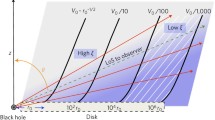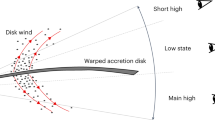Abstract
We discuss the structure of a radiatively-driven wind from a rapidly rotating hot star. When the rotation rate is large, there is a region at low latitudes near the stellar surface where the force of gravity is larger than the radiation pressure. Within this region, the streamlines “fall” toward the equator, and if the rotation rate is large enough, the fluid collides with the flow from the opposite hemisphere of the star. The shock compression and subsequent cooling produces a dense equatorial disk. This wind-compressed disk forms only if the star is rotating fast enough. The rotation threshold for disk formation is about 70% of the break-up speed for B stars and is much higher for O stars. If theoretical calculations of the terminal speed are correct, then the behavior of the disk formation threshold as a function of spectral type potentially explains the frequency distribution of Be stars. The geometry of the wind-compressed disk agrees quite well with observations of Be stars; however, the disk density is a factor of 100 too small to explain the magnitude of the IR excess, optical polarization, and Hα emission, if current UV mass-loss rates are correct. However, recent X-ray observations indicate that the mass-loss rates of B stars may be much larger than previously thought.
Similar content being viewed by others
References
Bjorkman, J.E., and Cassinelli, J.P.: 1992, ‘The Wind Compressed Disk Model of Be Stars’ in L. Drissen, C. Leitherer, and A. Nota, ed(s).,A.S.P. Conf. Series, Vol. 22, Nonisotropic and Variable Outflows from Stars, (A.S.P.: San Francisco), 88
Bjorkman, J.E., and Cassinelli, J.P.: 1993,Astrophysical Journal 409, 429
Bjorkman, K.S.: 1989, Ph.D. Thesis, University of Colorado
Friend, D.B., and Abbott, D.C.: 1986,Astrophysical Journal 311, 701
Grady, C.A., Bjorkman, K.S., and Snow, T.P.: 1987,Astrophysical Journal 320, 376
Grady, C.A., Bjorkman, K.S., Snow, T.P., Sonneborn, G., Shore, S.N., and Barker, P.K.: 1989,Astrophysical Journal 339, 403
Owocki, S.P., Cranmer, S.R., and Blondin, J.M.: 1993, ‘Two-Dimensional Hydrodynamical Simulations of Wind Compressed Disks Around Rapidly Rotating B-Stars’ (preprint submitted to theAstrophysical Journal) (OCB)
Waters, L.B.F.M., Coté, J., and Lamers, H.J.G.L.M.: 1987,Astronomy and Astrophysics 185, 206
Author information
Authors and Affiliations
Rights and permissions
About this article
Cite this article
Bjorkman, J.E. Effects of rotation on hot star winds. Astrophys Space Sci 221, 443–453 (1994). https://doi.org/10.1007/BF01091174
Issue Date:
DOI: https://doi.org/10.1007/BF01091174




